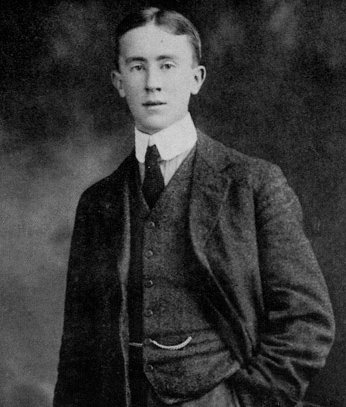In the midst of trench fever, John Ronald Reuel Tolkien, signals officer with the Lancashire Fusiliers, began hallucinations that would forever change him. He was meant to have been invalided the day before, but he chose to stay behind to let another, sicker soldier take his place. Still in the miserable conditions of the trenches, Tolkien relapsed the next day into a high fever, crippling muscle soreness in his legs, and stabbing pain in his eyes. Others went to fetch a medic while he remained propped in the dark of a supply tent, near an unused machine gun. He had listened to the thunderous blasts of machine gun fire often in training in Staffordshire and later in combat during the Somme offensive.
This time, however, the noise was only in his mind, which translated the mechanical pattering into a language. He thought he could just about translate the words, a series of taps as if a living telegraph key, reassuring him that the gun would fight on just as a fellow soldier would. When medics arrived to take him away from the front, he told them, “The gun. It shall fight on.”
Tolkien returned to England and to his wife, Edith, whom he had married three years before after five years of waiting due to his guardian's refusal they see one another before Tolkien was 21. He would spend the rest of the war alternately in hospitals or on light guard duty since he was too ill with recurrent fever to participate other than stints in camps on the home front, but honor kept him in the service until the end of the war. While recovering, Tolkien would begin writing fanciful stories, mixing the worlds of myth he had always studied with his new ideas of animated machines. He devoured science romances of Jules Verne and the like, but the use of machines as tools carried too little personification. Instead, Tolkien created machines that were as human as men, with personalities and special skills, just as the dwarves or elf creatures in Northern European myth. One of his first stories, "Fall of Gondolin" told of a city made of machines, each working its duty to create a glorious world, and its betrayal and destruction by the armies of an industrial behemoth monster called Morgoth ("Black Foe of the World" in Klindirin, a clicking language he invented for his machines).
Tolkien was not the only fiction-writer fascinated with intelligent machines. Just after the turn of the century, Frank L. Baum wrote about Tik-tok, a living clockwork being. The idea was taken further in 1921 by the Czech playwright Karel Capek in his play R.U.R. (Rossum’s Universal Robots), first coining the term “robot” for a humanlike automaton built to do work. Films would soon have their own robots with Fritz Lang’s Metropolis in 1927 giving a robot indistinguishable from the human Maria. In all of these, the machines were written to emulate humans, but Tolkien’s stories went further, creating a world complete with history, language, and culture with different races of machines, not metal emulations of humanity. His studies of myth, particularly Beowulf, turned him to a sense of social tribalism and competition over resources. In 1936, Tolkien published The Robbit about a portly, quiet machine chosen by a magical Tinkerer to join a quest to liberate a coal mine from Smaug, an ancient predatory machine. This and the following Bearing trilogy would inspire the next generation of science fiction writers such as Isaac Asimov and Arthur C. Clarke.
While he would continue to write during his free time, Tolkien's professional life kept him busy. He worked for the Oxford English Dictionary, became the youngest professor at the University of Leeds, and finally settled at Oxford first at Pembroke College and then Merton, becoming chair of English Language and Literature. Tolkien often ate with fellow writers in a club nicknamed “The Inklings”, including C.S. Lewis, the unquestioned Father of Modern Fantasy with his Wardrobe tales. In World War II, Tolkien served his country again as a code-breaker (though was notoriously vocal about his anti-war sentiments) and worked alongside men such as Alan Turing, who would be inspired by Tolkien’s ideas on machine communication. While Tolkien never officially worked on computer development projects, he and Turing kept close correspondence, even through Turing’s indecency debacle in the early ‘50s. Shortly before Tolkien’s death in 1973, Turing’s Beren system came online, creating the first vocal command interface and allowing man and machine to talk just as Tolkien dreamed. Mankind would far surpass Arthur C. Clarke’s description of a “HAL 9000” by its fictional birth date in 1997 for his 2001: A Space Odyssey.
--
In reality, Tolkien was invalided to England on November 8, 1916. He wrote extensively in the style of ancient myth, giving new life to the High Fantasy genre that supplied depth and poetry to literature that was often considered nothing but pulp adventure.

Anybody using this idea in their SF at this time? Glances around...Hmmm. Makes notes.
ReplyDeleteBlimey, one of your best so far.
ReplyDelete